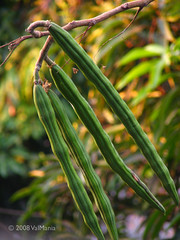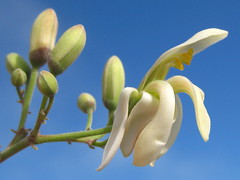Malunggay, Miracle
Tree
Part 1
Today I want
to start telling you about one of my new favorite ingredients, Malunggay. This
may take more than just one post as this is a wonder of nature. I admit I was
slow to try it. I will normally try anything but for some reason I just didn’t
get around to Malunggay even though I saw it every day. When I did try it, I
hated that I waited so long and then when I researched it, I wish I had been
eating it every day.
 |
| Moringa Oleifera (Photo credit: ValMan) |
The
Malunggay tree is known by many names moringa , horseradish tree, benzolive
tree, kelor, marango, mlonge, moonga, nébéday, saijhan, sajna or Ben oil tree,
drumstick tree and many others. It was originally a native of the Himalayan
foot hills but has spread throughout Asia and many other regions of the world.
It is a hardy plan that will tolerate a wide temperature range; it is drought
resistant and tolerates poor soil very well. Because of these traits and others
that will become apparent. Malunggay is seen as one possible solution to famine
relief in many areas.
 |
| Moringa oleifera (Photo credit: tonrulkens) |
There is no
part of the moringa tree that cannot be utilized for food in some way. The
roots have a pulpy core with a taste reminiscent of Horseradish. The British
soon discovered this after coming to India and used it in sauces for their
meals. The bark can be used as a seasoning and gives a warm almost peppery
flavor. The young Bean bods or drum sticks as the Brits called them are normally
parboiled while the mature bods are shelled and the beans eaten like peas or roasted
and eaten like nuts. These are very tasty. The bean is also a good source of
oil yielding up to 40% of their wait. This oil known as Ben oil is highly resistant
to rancidity and even shows promise as a biofuel. The leaves are my favorite
part. They have a lite green taste and can be incorporated into almost type of
food. Here in the Philippines they are used as a true green boiled or added to
soups, or my favorite way, ground and added to the dough for Pandesal, a
Filipino type of sweet bread.
This is just
a basic introduction to a wonderful plant. I hope to make you more familiar
with. I have not even touched on the wonderful nutrition or health benefit
facts this plant can bring to our tables. Those subjects will have to wait until
my next installment on this subject. You’ll understand why it is being called “The
Miracle Tree”. Look for it next Friday. Same Bat Time, Same Bat Channel. Enjoy!



I have chosen you as one of the lucky recipients of the Liebster Award! I am passing this along to you in appreciation of your creativity, fearless sharing and blogging support.
ReplyDeleteVisit my blog to copy your Liebster badge and get instructions!
thisistrix.blogspot.com/
Thank you for sharing,
GKP